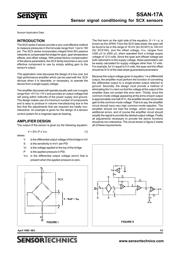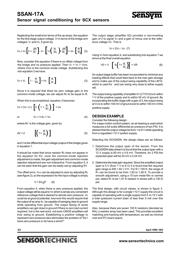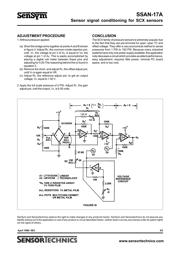herunterladen

1/3April 1999 / 083
SSAN-17A
Sensor signal conditioning for SCX sensors
www.sensortechnics.com
The first term on the right side of the equation, S • V • p, is
known as the SPAN. From the SCX data sheet, the span will
be found to be in the range of 18 mV (for SCX01) to 100 mV
(for SCX100), and the offset voltage, VOS, ranges from
±300 µV to ±500 µV, when operated from a bridge supply
voltage of 12.0 volts. Since the span and offseet voltage are
both ratiometric to the supply voltage, these parameters can
be easily calculated for supply voltages other than 12 volts.
For example, for VS equal to 5.0 volts, the span and the offset
should be 5/12 of the data sheet guaranteed parameters.
Because the output voltage given in equation 1 is a differential
output, the amplifier must perform the function of converting
the differential output to a single-ended output referred to
ground. Secondly, the design must provide a method of
eliminating the VOS term so that the voltage at the output of the
amplifier does not contain this error term. Thirdly, since the
common-mode voltage appearing at the arms of each output
is approximately one half of VS, the amplifier should not provide
gain to this common-mode voltage. That is to say, the amplifier
circuit should have very high common-mode rejection. The
amplifier should not load the bridge, which would cause
additional errors, and of course the amplifier circuit should
amplify the signal to provide the desired output voltage. Finally
all adjustments necessary to provide the above functions
should be non-interactive. The circuit shown in figure 2 meets
all of these requirements.
Sensym Application Dept.
INTRODUCTION
The SCX series if sensor provide a very cost effective method
to measure pressures in the full scale range from 1 psi to 150
psi. The SCX series incorporates integral thick film passive
networks to compensate the bridge for span, span temperature
effects, and offset voltage. With preset factory compensation
of the above parameters, the SCX family becomes a very cost
effective component to use by simply adding gain to the
sensor's output.
This application note discusses the design of a low cost, but
high performance amplifier which can be used with the SCX
devices when it is desirable, or necessary, to operate the
device from a single supply voltage.
The amplifier discussed will operate equally well over a supply
range from +5 V to +15 V and provides an output voltage that
will swing within millivolts of the power supply and ground.
The design makes use of a minimum number of components
and is easy to produce in volume manufacturing due to the
fact that the adjustments that are required are totally non-
interactive. An example is given for the design of a tension
control system for a magnetic tape air bearing.
AMPLIFIER DESIGN
The output of the sensor is given by the following equation:
V = SVS P ± VOS (1)
where:
V is the differential output voltage of the bridge in mV
S is the sensitivity in mV/V per PSI
V
S is the voltage applied to the top of the bridge
P is the applied pressure in PSI.
VOS is the differential output voltage (error) that is
present when the applied pressure is zero.
SCX
FIGURE I
FIGURE II





